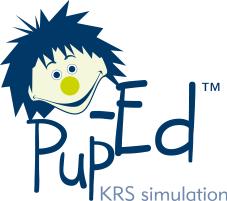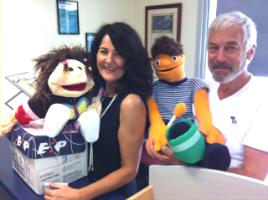Puppets arrive for Noosa nursing simulations
Published on 07 February, 2012
CQUniversity Noosa has received its first batch of puppets designed to be used as educational tools in nursing simulations.
These new resources are an offshoot from the MASK-EDTM (KRS simulation) tool devised by CQUniversity nursing academic Dr Kerry Reid-Searl.
While the masked educator concept enables lecturers to inhabit an adult character, the Pup-EdTM (KRS simulation)* puppets can be used as a means to engage, teach, play and communicate with learners.
CQUniversity Noosa lecturer Carol McPherson says academics are keen to introduce Pup-EdTM to residential schools for nursing students which will be hosted at the Noosa Campus this year.
* Pup-EdTM (KRS simulation) is a teaching technique where puppets are worn by a wearer who is an informed professional. Pup-EdTM (KRS simulation) is an acronym for the teaching approach developed for the technique.
The acronym stands for P-puppet and professional preparation, U- understanding the learner, P-play in action to suspend disbelief, E- evaluation, D- debrief. The KRS component stands for knowledgeable, realistic and spontaneous simulation.

A logo for the new teaching resources
The 'knowledgeable' implies that the wearer of the puppet has a deep understanding of the content being imparted as well as an understanding of different learning styles in order to develop strategies in the puppet experience to engage the learners.
'Realistic' suggests that the puppet experience mimics a real situation and the learner is suspended in disbelief. The reality comes from the experience of the wearer who should have a deep understanding of their discipline and simulation. For example in nursing, the professional wearing the puppet - (being the nurse), can draw upon episodes of patient care relevant to the content, the objectives of the episode and learner level.
'Spontaneous' implies that the reaction of the puppet is unprompted. However, the puppet is directed by the professional who is, in turn, influenced by the learner response. Because scripts are not set, the reactions can be immediate in response to learners.
The purpose of this technique is for the professional to use puppets as a means to engage, teach, play and communicate with learners.
The puppets can be used in different contexts and the learners can be diverse. For example the learners could be university nursing students in a classroom; children in a paediatric unit, children in a classroom with differing needs or a child undergoing counselling.
The informed professional could be a nurse educator teaching undergraduate nursing students, the experienced registered nurse in the paediatric unit, the teacher in the classroom or the psychologist in a counselling session with a child. The contexts can, in essence, be any setting involving children or where there is a need for teaching individuals who will be involved with children.


